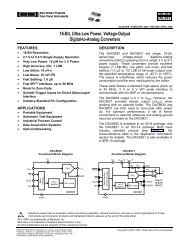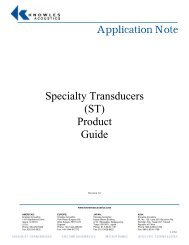DAC8532: Dual-Channel, Low-Power, 16-Bit, Serial-Input ... - dreamm
DAC8532: Dual-Channel, Low-Power, 16-Bit, Serial-Input ... - dreamm
DAC8532: Dual-Channel, Low-Power, 16-Bit, Serial-Input ... - dreamm
You also want an ePaper? Increase the reach of your titles
YUMPU automatically turns print PDFs into web optimized ePapers that Google loves.
THEORY OF OPERATION<br />
DAC SECTION<br />
The architecture of each channel of the <strong>DAC8532</strong> consists of<br />
a resistor string DAC followed by an output buffer amplifier.<br />
Figure 1 shows a simplified block diagram of the DAC<br />
architecture.<br />
V REF<br />
2<br />
R<br />
V REF<br />
R DIVIDER<br />
DAC Register<br />
V REF<br />
REF (+)<br />
Resistor String<br />
REF(–)<br />
V OUT X<br />
R<br />
To Output<br />
Amplifier<br />
(2x Gain)<br />
GND<br />
Output<br />
Amplifier<br />
FIGURE 1. <strong>DAC8532</strong> Architecture.<br />
The input coding for each device is unipolar straight binary,<br />
so the ideal output voltage is given by:<br />
D<br />
VOUTX = VREF<br />
• 65536<br />
where D = decimal equivalent of the binary code that is<br />
loaded to the DAC register; it can range from 0 to 65535.<br />
V OUT X refers to channel A or B.<br />
RESISTOR STRING<br />
The resistor string section is shown in Figure 2. It is simply<br />
a divide-by-2 resistor followed by a string of resistors, each<br />
of value R. The code loaded into the DAC register determines<br />
at which node on the string the voltage is tapped off.<br />
This voltage is then applied to the output amplifier by closing<br />
one of the switches connecting the string to the amplifier.<br />
OUTPUT AMPLIFIER<br />
Each output buffer amplifier is capable of generating rail-torail<br />
voltages on its output which approaches an output range<br />
of 0V to V DD (gain and offset errors must be taken into<br />
account). Each buffer is capable of driving a load of 2kΩ in<br />
parallel with 1000pF to GND. The source and sink capabilities<br />
of the output amplifier can be seen in the typical characteristics.<br />
SERIAL INTERFACE<br />
The <strong>DAC8532</strong> uses a 3-wire serial interface (SYNC, SCLK,<br />
and D IN ), which is compatible with SPI, QSPI, and<br />
Microwire interface standards, as well as most DSPs. See<br />
the <strong>Serial</strong> Write Operation timing diagram for an example of<br />
a typical write sequence.<br />
R<br />
R<br />
FIGURE 2. Resistor String.<br />
The write sequence begins by bringing the SYNC line LOW.<br />
Data from the D IN line is clocked into the 24-bit shift register<br />
on each falling edge of SCLK. The serial clock frequency can<br />
be as high as 30MHz, making the <strong>DAC8532</strong> compatible with<br />
high speed DSPs. On the 24th falling edge of the serial clock,<br />
the last data bit is clocked into the shift register and the<br />
programmed function is executed (i.e., a change in Data<br />
Buffer contents, DAC Register contents, and/or a change in<br />
the power-down mode of a specified channel or channels).<br />
At this point, the SYNC line may be kept LOW or brought<br />
HIGH. In either case, the minimum delay time from the 24th<br />
falling SCLK edge to the next falling SYNC edge must be met<br />
in order to properly begin the next cycle. To assure the<br />
lowest power consumption of the device, care should be<br />
taken that the digital input levels are as close to each rail as<br />
possible. (Please refer to the “Typical Characteristics” section<br />
for the “Supply Current vs Logic <strong>Input</strong> Voltage” transfer<br />
characteristic curve).<br />
SPI and QSP are registered trademarks of Motorola.<br />
Microwire is a registered trademark of National Semiconductor.<br />
10<br />
www.ti.com<br />
<strong>DAC8532</strong><br />
SBAS246A















